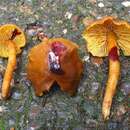ar
الأسماء في صفحات التنقل


Guidance for identification
Callistosporium luteo-olivaceum is a species of agaric fungus in the family Tricholomataceae. It was originally described in 1859 as Agaricus luteo-olivaceus by Miles Joseph Berkeley and Moses Ashley Curtis in 1859. Rolf Singer transferred it to Callistosporium in 1946. The fungus has an extensive synonymy.[1] Although rare, C. luteo-olivaceum is widely distributed in temperate and tropical areas of Europe and North America.[2] In 2014, it was reported growing in pine forests in Western Himalaya, Pakistan.[3] The species is inedible.[4]
The caps are brownish, as are the stipes, which are fibrillose and hollow, with yellowish tomentum near the base.[5] The spores are colorless but produce a yellow color in ammonia.[5]
Callistosporium luteo-olivaceum is a species of agaric fungus in the family Tricholomataceae. It was originally described in 1859 as Agaricus luteo-olivaceus by Miles Joseph Berkeley and Moses Ashley Curtis in 1859. Rolf Singer transferred it to Callistosporium in 1946. The fungus has an extensive synonymy. Although rare, C. luteo-olivaceum is widely distributed in temperate and tropical areas of Europe and North America. In 2014, it was reported growing in pine forests in Western Himalaya, Pakistan. The species is inedible.
The caps are brownish, as are the stipes, which are fibrillose and hollow, with yellowish tomentum near the base. The spores are colorless but produce a yellow color in ammonia.
Capel fin a 5 cm, pòch igròfan, da òcra olivastr a gris vërdastr an sëccand. Gamba àuta fin a 8 cm e larga fin a 0,6 cm, fibrilosa. Lamele s-ciasse, strèite, giàune, dël midem color o a arfless vinos.
A chërs a bocc, dzora a bòsch ëd conìfera o ëd latifeuja sempevërda.
![]() A venta mai mangé un bolè trovà se un a l'é nen un bon conossidor dij bolè!
A venta mai mangé un bolè trovà se un a l'é nen un bon conossidor dij bolè!
Sensa anteresse alimentar.
Capel fin a 5 cm, pòch igròfan, da òcra olivastr a gris vërdastr an sëccand. Gamba àuta fin a 8 cm e larga fin a 0,6 cm, fibrilosa. Lamele s-ciasse, strèite, giàune, dël midem color o a arfless vinos.
AmbientA chërs a bocc, dzora a bòsch ëd conìfera o ëd latifeuja sempevërda.
Comestibilità![]() A venta mai mangé un bolè trovà se un a l'é nen un bon conossidor dij bolè!
A venta mai mangé un bolè trovà se un a l'é nen un bon conossidor dij bolè!
Sensa anteresse alimentar.
Callistosporium luteo-olivaceum é uma espécie de fungo agárico pertencente à família Tricholomataceae, da ordem Agaricales. Foi originalmente descrita como Agaricus luteo-olivaceus por Miles Joseph Berkeley e Moses Ashley Curtis em 1859. Rolf Singer transferiu a espécie para o gênero Callistosporium em 1946. O fungo tem uma extensa sinonímia.[1] Embora seja raro, a espécie é amplamente distribuída em áreas temperadas e tropicais da Europa e da América do Norte.[2] Em 2014, foi relatado o crescimento em florestas de pinheiros no oeste do Himalaia, no Paquistão.[3]
Callistosporium luteo-olivaceum é uma espécie de fungo agárico pertencente à família Tricholomataceae, da ordem Agaricales. Foi originalmente descrita como Agaricus luteo-olivaceus por Miles Joseph Berkeley e Moses Ashley Curtis em 1859. Rolf Singer transferiu a espécie para o gênero Callistosporium em 1946. O fungo tem uma extensa sinonímia. Embora seja raro, a espécie é amplamente distribuída em áreas temperadas e tropicais da Europa e da América do Norte. Em 2014, foi relatado o crescimento em florestas de pinheiros no oeste do Himalaia, no Paquistão.